Source: Pantera Capital
Original Title: DAT Value Creation
Compiled and Organized by: BitpushNews
Preface:
Cryptocurrency venture capital firm Pantera Capital has revealed for the first time in its latest blockchain letter that it has invested over $300 million in Digital Asset Treasury (DAT) companies to date. DATs are publicly traded companies that hold cryptocurrency reserves on their balance sheets, and their numbers are continuously growing.
Pantera states that its investment philosophy regarding DAT companies is simple: "DATs can generate income, thereby increasing net asset value per share over time, giving you more underlying token ownership than merely holding spot. Therefore, holding DATs can provide higher return potential compared to directly holding tokens or holding tokens through ETFs."
Here is the original text:
DAT VALUE CREATION
Our investment philosophy regarding Digital Asset Treasury companies (referred to as DATs) is based on a simple premise:
DATs can enhance net asset value (NAV) per share by generating income, thus holding more underlying tokens over time than simply holding spot.
Therefore, holding DATs may provide higher return potential compared to directly holding tokens or through ETFs.
Pantera has deployed over $300 million across various tokens and capital market DATs. These DATs are leveraging their unique advantages and adopting strategies to increase their digital asset holdings in a per-share appreciation manner. Below is an overview of our DAT investment portfolio.
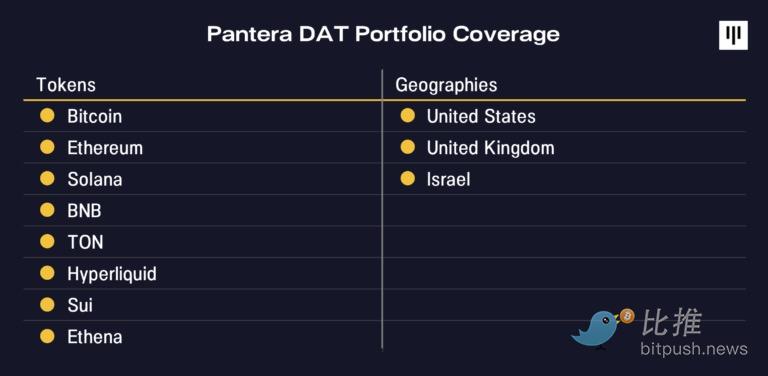
BitMine Immersion (BMNR) is the first investment of the Pantera DAT fund, exemplifying a company with a clear strategic blueprint and execution capability. As chairman, Tom Lee of Fundstrat has outlined BitMine's long-term vision: to acquire 5% of the total supply of Ethereum—what they call "5% Alchemy." We believe it is valuable to study BMNR as a case of an efficiently executing DAT.
BitMine (BMNR) Case Study
Since BitMine launched its treasury strategy, it has become the largest Ethereum treasury globally and the third-largest DAT (after Strategy and XXI), holding 1,150,263 ETH valued at $4.9 billion (as of August 10, 2025). BNMR is also ranked 25th in U.S. liquidity, with a daily trading volume of $2.2 billion (as of the five-day moving average on August 8, 2025).
The Ethereum Case
The key element of success for DATs is the long-term investment value of their underlying tokens.
The DATs philosophy of BitMine is based on a core argument: as Wall Street migrates on-chain, Ethereum will become one of the most important macro trends of the next decade. As we wrote in last month's letter, with the increasing importance of tokenization innovation and stablecoins, a "great on-chain migration" is underway. Currently, there are $25 billion of real-world assets on public blockchains—not including the $260 billion in stablecoins, which have collectively become the 17th largest holder of U.S. Treasury bonds.
"Stablecoins have become the ChatGPT story of the crypto world."
— Tom Lee, Chairman of BitMine, Pantera DAT conference call, July 2, 2025
Most of these activities are happening on Ethereum, allowing ETH to benefit from the growing demand for block space. As financial institutions increasingly rely on Ethereum's security to support their operations, they will be incentivized to participate in its proof-of-stake network—thus driving further accumulation of ETH.
Growing ETH Per Share (“EPS”)
After determining the investment value of the underlying tokens, the business model of DATs is to maximize their token ownership on a per-share basis. There are several main ways to grow the per-share token holdings (ETH per share, “EPS”):
- Issuing stock at a premium above the per-share token NAV.
- Issuing convertible bonds and other equity-linked securities to capitalize on the volatility inherent in stocks and underlying tokens.
- Acquiring more tokens through staking rewards, DeFi yields, and other operational income. Notably, this is an additional means unique to ETH and other smart contract token DATs, which the original Bitcoin DATs (including Strategy) do not possess.
- Acquiring another DAT whose trading price is close to or below NAV.
At this point, BitMine has rapidly increased its per-share ETH (coincidentally also abbreviated as “EPS”) at an astonishing rate in the first month of launching its ETH treasury strategy, far surpassing other DATs. The amount of ETH accumulated by BitMine in the first month exceeded that of Strategy (formerly MicroStrategy) in the first six months of executing its strategy.
BitMine primarily increases EPS through issuing stock and generating staking rewards, and we believe BitMine is likely to soon expand its strategy to begin issuing convertible bonds and other financial instruments.
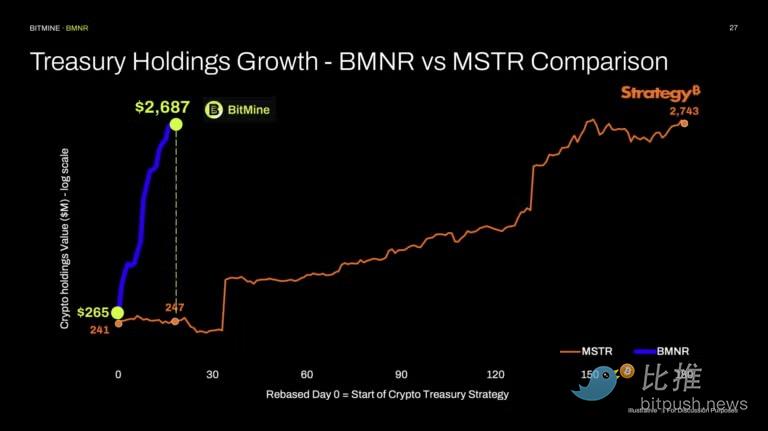
Value Creation Example
The price of DATs can be broken down into the product of three factors:
(a) The number of tokens per share,
(b) The price of the underlying token,
and (c) The multiple of NAV (“mNAV”).
At the end of June, BMNR's stock price was $4.27 per share, approximately 1.1 times its initial DAT financing NAV of $4 per share. Just over a month later, the stock closed at $51, about 1.7 times its estimated NAV of $30 per share. This represented a 1100% price increase in just over a month, where:
(a) EPS growth of approximately 330% contributed about 60% of the increase;
(b) The ETH price rose from $2.5k to $4.3k, contributing about 20% of the increase;
(c) The mNAV multiple expanded to 1.7 times, contributing about 20% of the increase.
This means that the vast majority of the increase in BMNR's stock price was driven by the growth in the underlying number of ETH per share, which is the core engine controllable by management, and is precisely what differentiates DATs from merely holding spot.
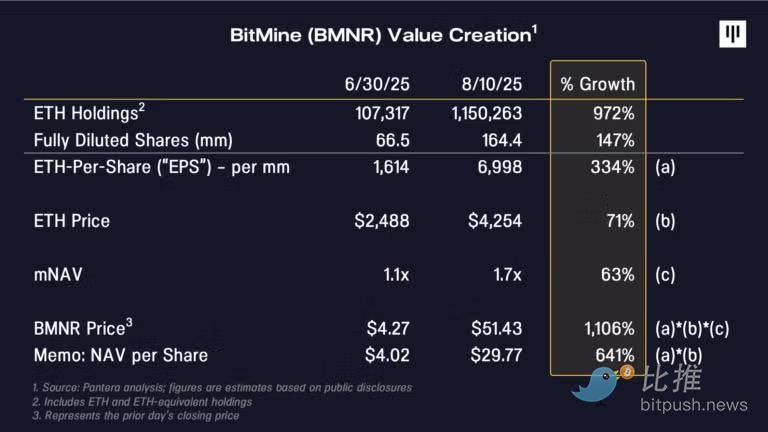
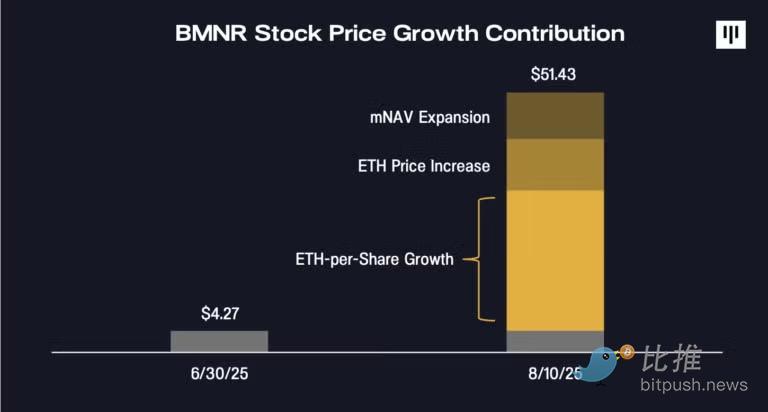
The third factor we have yet to discuss is mNAV. Naturally, one might ask: why would anyone be willing to buy DATs at a premium to NAV?
Here, I find it useful to draw an analogy with banks and other asset-based financial enterprises.
Banks attempt to generate returns on their assets, and investors will give a valuation premium to those they believe can sustainably generate returns above their cost of capital. The highest quality banks, such as JPMorgan, trade at more than twice their NAV (or book value).
Similarly, if investors believe a DAT can sustainably grow its per-share NAV, they will also choose to value it at a premium above NAV. We believe that BMNR's achievement of approximately 640% growth in per-share NAV in just one month is sufficient to justify its mNAV premium.
Whether BitMine can continue to effectively execute its strategy will become evident over time, and it will inevitably face challenges along the way.
However, BitMine's management team and performance record to date have attracted support from heavyweight figures in traditional finance, including Stan Druckenmiller, Bill Miller, and ARK Invest. We expect that the growth story of the highest quality DATs will gain recognition from more institutional investors, just as Strategy has experienced.
Ethereum's Tenth Anniversary
July 30 marks the tenth anniversary of Ethereum.
The first time I met Vitalik Buterin, he was a 17-year-old reporter for Bitcoin Magazine!
In 2014, we met again on the "Colored Coins" project—an intriguing precursor to today's RWAs, NFTs, and various asset-backed tokens. He proposed the concept of Ethereum in January 2015.
Its development has been truly remarkable. A decade of stable operation and uninterrupted transactions. Ten years of innovation and reshaping the future of global markets.
We have supported numerous visionary teams and developers who have built applications and infrastructure that drive Ethereum's mission forward. Our commitment to this ecosystem remains steadfast. The work is not yet complete.
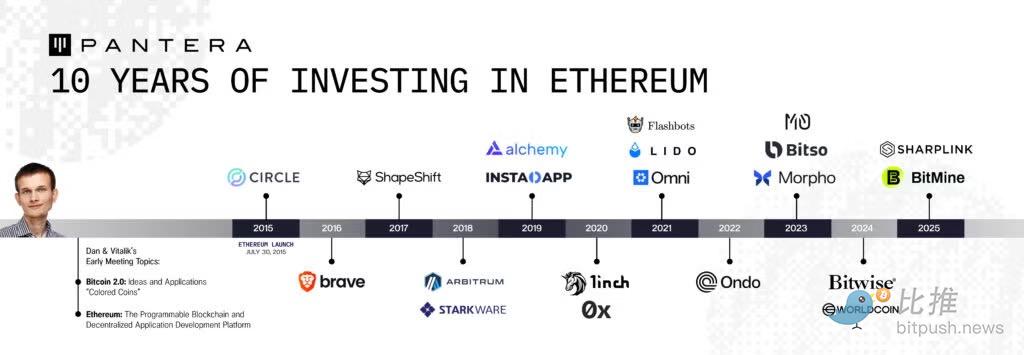
The Revival of Prediction Markets: Everything is Marketable
The revival of prediction markets is underway. While new prediction markets occasionally emerge, there are now numerous prediction trading platforms for various market event types, formats (such as mobile, Tinder-like swipe interfaces, trading terminals), and regions.
This revival is catalyzed by several events:
- The success of Polymarket and Kalshi: Prediction markets continue to achieve billions of dollars in monthly trading volume. Their success—especially in the election markets following the 2024 U.S. presidential election—demonstrates the demand for event-based markets.
- Regulatory clarity for prediction market event contracts: On October 2, 2024, the D.C. Circuit Court of Appeals denied a request for a stay, allowing Kalshi to launch its election contracts. Robinhood also launched its election market in the same month. The clarity of regulation has an astonishing impact on the innovation companies in financial markets.
- The rise of a speculative generation: The median age of first-time homebuyers is 38, significantly rising over the past few years. Retail zero-day options trading is about to account for two-thirds of all daily options trading volume, indicating that retail investors are eager for quick wins in volatile markets. The "TikTokification" of financial markets continues, accompanied by a desire to bet on more markets until there is nowhere left to bet.
While the speculative allure of prediction markets drives participation, these markets are far from useless. By aligning incentives with information, they can help uncover accurate information and insights.
Markets help predict outcomes, and various new markets are emerging—including predictions for political events, corporate earnings forecasts, weather forecasts, and FDA drug approvals.
As prediction markets grow, many teams are taking different product directions and market entry strategies. From an investment perspective, I believe that new prediction markets that achieve long-term success will focus on building excellent products that serve markets with the following common characteristics:
- Markets where events occur very frequently
- Markets with high leverage or the ability to win huge returns with a small amount of capital
- Markets with high outcome value—i.e., the predictive value itself has signal significance
Let’s discuss this in more detail:
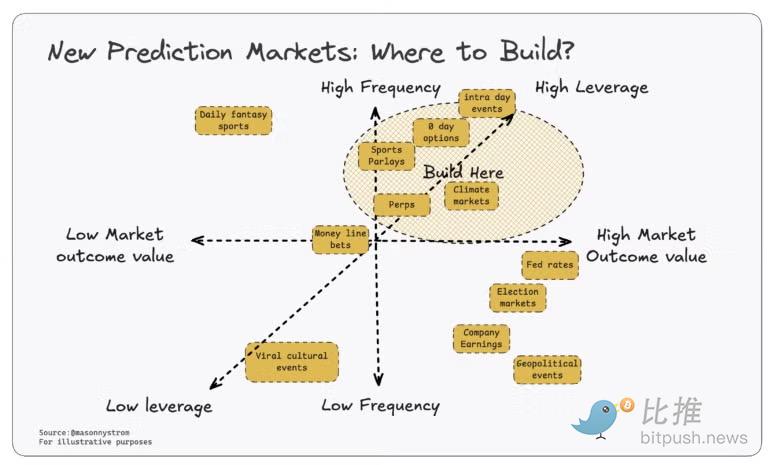
High Leverage
Users want high leverage or compounded odds to increase returns. Parlay bets, perpetual contracts, intraday event markets—all of these prediction market products have the potential to increase demand for prediction market events. Imagine the midterm elections; if someone could make correct parlay bets on all outcomes. Considering the rise of zero-day options, intraday markets (half-day, a few hours, a few minutes) are also worth considering.
High-Frequency Prediction Markets
Prediction markets are habitual—users come to bet on markets they are interested in. More markets help maintain user engagement, but what truly matters is the existence of high-frequency markets, which drive user retention.
Users wanting to bet on one-time high-attention events (presidential elections, pop culture events, etc.) can do so on any platform, and they are likely to use the platform they visit most often. Having more recurring markets will also create better economic benefits for the platform, allowing them to list more markets, pay customer acquisition costs, or be more competitive in other ways. This has already happened in sports betting, where platforms like DraftKings use DFS (Daily Fantasy Sports) as a valuable customer acquisition and retention tool, fostering habitual behavior among users.
High Market Outcome Value
Elections are not frequent events, but they have high signal value. This attracts a large amount of capital into these markets.
Polymarket recently released FDA approval results, decisions that can make or break companies worth billions of dollars. Kalshi's climate market has predictive signal value, and theoretically, other types of derivative contracts can be built based on a large number of daily predictive signals. Markets with high outcome value will drive higher trading volumes and deeper liquidity.
In contrast, many pop culture markets—reality shows, Grammy winners, Nobel Prize winners—while betting may be entertaining, have lower outcome value. Sometimes the outcome value is low partly because the results may be manipulated. A prediction market combining shows like "Survivor" would be interesting, but if the betting amounts are large enough, people will find ways to manipulate the market.
The popularity of prediction markets will leverage efficient markets to generate valuable predictive insights and provide a leveraged form of entertainment for the same group of customers trading individual stocks or engaging in sports betting. We are about to see an explosion of market types and things people can bet on. The era of "Markets for Everything" is approaching.
Entering the Second Phase of the Bull Market
Bitcoin often leads the bull market cycle, while altcoins tend to lag in the early stages. As the cycle progresses, altcoins usually gain momentum and outperform Bitcoin towards the end of the cycle. We refer to this as the "first phase" and "second phase" of the bull market.
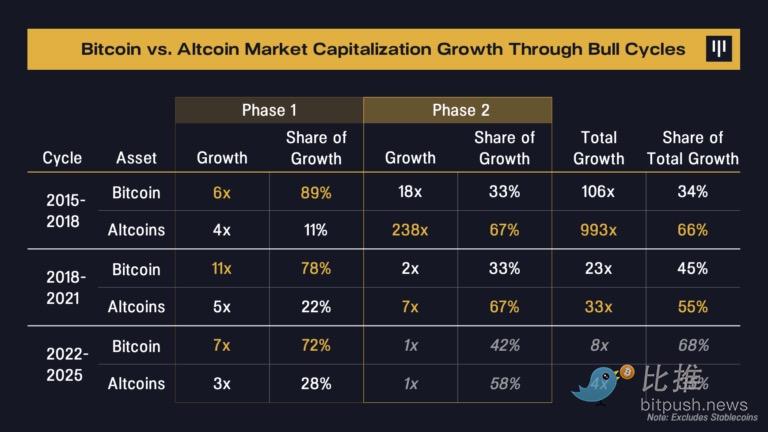
Importantly, in the past two cycles, altcoins contributed the majority of value creation. In the 2015-2018 cycle, altcoins accounted for 66% of the total market cap growth in crypto. In the 2018-2021 cycle, they contributed 55%.
So far, in this current cycle, altcoins have only accounted for 35% of the total market growth.
For a long time, Bitcoin has benefited from regulatory clarity—not only because it is classified as a commodity but also because its role as "digital gold" is well understood. This was a key driver for its outperformance over altcoins in the early stages of this cycle, as altcoins have historically faced greater regulatory uncertainty—until recently. With the new government in place, this dynamic is shifting, driving meaningful progress in digital asset innovation.
Historically, the regulatory clarity and favorable conditions that favored Bitcoin are now beginning to extend to altcoins. The market is starting to reflect this.
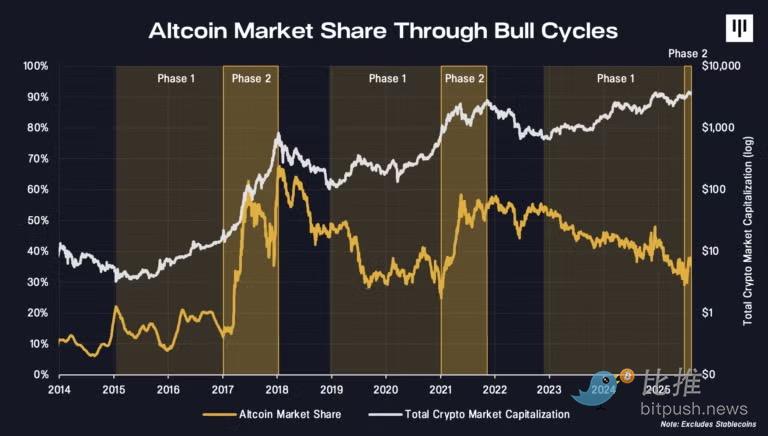
As regulatory victories continue to accumulate, momentum is building. Last month, President Trump signed the GENIUS Act into law, creating conditions for the prosperity of regulated stablecoins in the U.S., which could become an engine for global financial transactions. The CLARITY Act, which has passed the House, aims to establish clearer boundaries between digital commodities and digital securities—helping to resolve the long-standing jurisdictional uncertainty between the SEC and CFTC. A transformation is underway, and there is reason to believe that non-Bitcoin tokens will be among the biggest beneficiaries.
Innovation and development are accelerating, especially in the tokenization space. Robinhood recently launched stock tokens supported by Arbitrum, aimed at democratizing stock investment and creating more efficient markets. Major U.S. banks like Bank of America, Morgan Stanley, and JPMorgan are exploring issuing their own stablecoins. BlackRock's BUIDL fund has accumulated $2.3 billion in tokenized Treasuries. Figure has processed over $50 billion in blockchain-native RWA transactions. In addition to its tokenized Treasury fund, Ondo plans to offer over 1,000 tokenized stocks on the NYSE and NASDAQ through Ondo Global Markets. The great on-chain migration is underway.
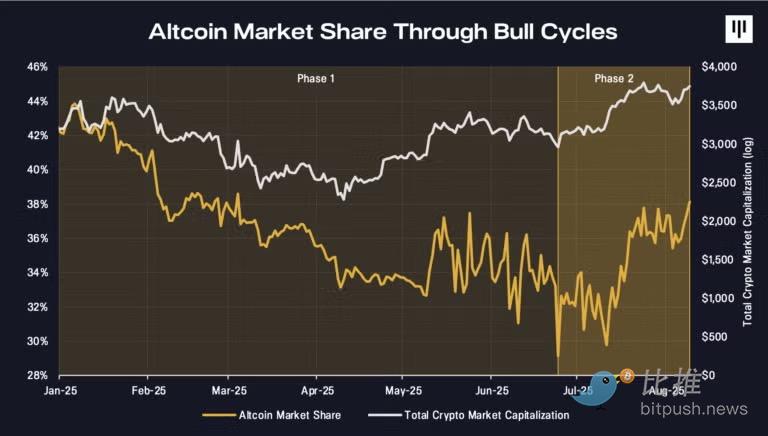
Ethereum Drives Growth in Non-Bitcoin Market Share
Most real-world assets are flowing into Ethereum.
In the $260 billion stablecoin market, 54% of stablecoins are issued on Ethereum. 73% of on-chain Treasury assets are on Ethereum. DATs are accumulating at unprecedented levels. Wall Street is realizing this, and demand for ETH is surging.
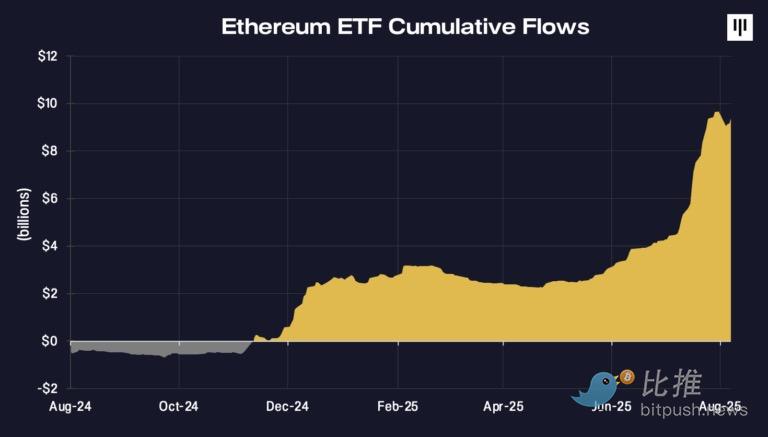
The price of Ethereum, measured in Bitcoin, has risen 103% since hitting a low in April 2025.
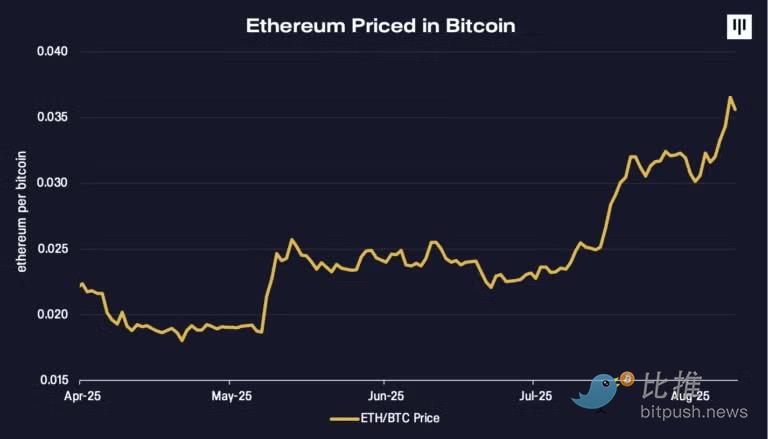
Bitcoin Halving Cycle – Precise Prediction
This is crazy!
During the crypto winter, we used research from the previous three Bitcoin halvings to predict that Bitcoin would reach $117,482 on August 11, 2025.
It really did!!!
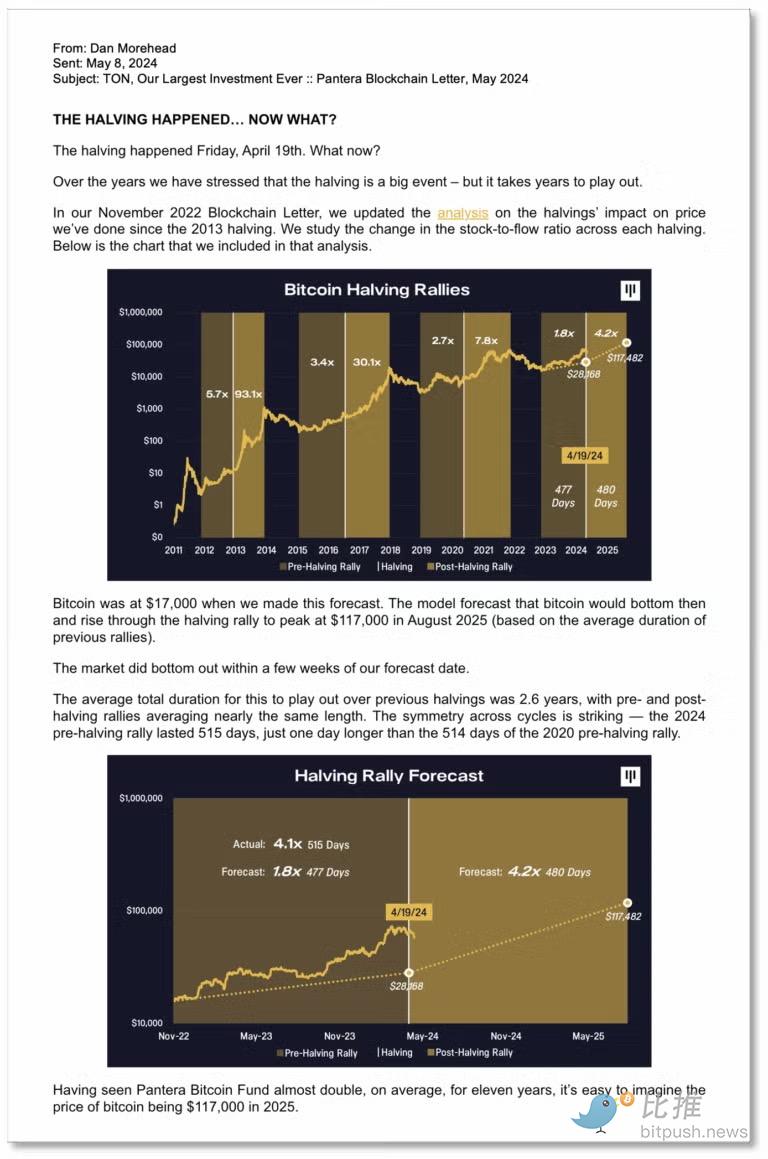
The Halving Happened… Updated Version
In our November 2022 Blockchain Letter, we updated our analysis of the impact of halving on prices since the 2013 halving. We studied the changes in the stock-to-flow ratio after each halving. The chart below is an updated version of our analysis at that time.
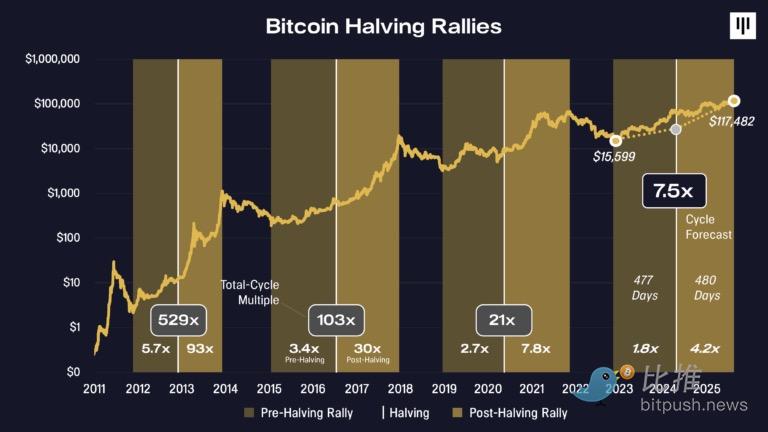
Wishing you a pleasant August,
“Let ‘Alternative’ Return to ‘Alts’” – Dan Pantera
免责声明:本文章仅代表作者个人观点,不代表本平台的立场和观点。本文章仅供信息分享,不构成对任何人的任何投资建议。用户与作者之间的任何争议,与本平台无关。如网页中刊载的文章或图片涉及侵权,请提供相关的权利证明和身份证明发送邮件到support@aicoin.com,本平台相关工作人员将会进行核查。




